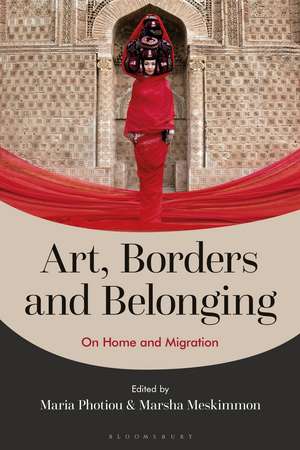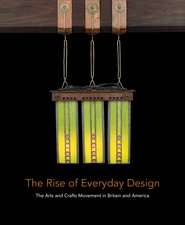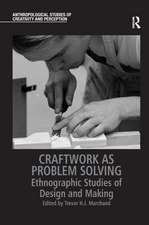Art, Borders and Belonging: On Home and Migration
Editat de Maria Photiou, Professor Marsha Meskimmonen Limba Engleză Paperback – 16 noi 2022
| Toate formatele și edițiile | Preț | Express |
|---|---|---|
| Paperback (1) | 197.42 lei 6-8 săpt. | |
| Bloomsbury Publishing – 16 noi 2022 | 197.42 lei 6-8 săpt. | |
| Hardback (1) | 599.25 lei 3-5 săpt. | |
| Bloomsbury Publishing – 19 mai 2021 | 599.25 lei 3-5 săpt. |
Preț: 197.42 lei
Preț vechi: 257.68 lei
-23% Nou
Puncte Express: 296
Preț estimativ în valută:
37.78€ • 39.44$ • 31.26£
37.78€ • 39.44$ • 31.26£
Carte tipărită la comandă
Livrare economică 04-18 aprilie
Preluare comenzi: 021 569.72.76
Specificații
ISBN-13: 9781350203105
ISBN-10: 1350203106
Pagini: 320
Ilustrații: 31 bw illus
Dimensiuni: 156 x 234 x 13 mm
Greutate: 0.32 kg
Editura: Bloomsbury Publishing
Colecția Bloomsbury Visual Arts
Locul publicării:London, United Kingdom
ISBN-10: 1350203106
Pagini: 320
Ilustrații: 31 bw illus
Dimensiuni: 156 x 234 x 13 mm
Greutate: 0.32 kg
Editura: Bloomsbury Publishing
Colecția Bloomsbury Visual Arts
Locul publicării:London, United Kingdom
Caracteristici
Refugees, asylum seekers and migrants are constantly in the news; this book delves deeper than the headlines through interdisciplinary analysis
Notă biografică
Maria Photiou is an Art Historian and a Research Fellow at the University of Derby, UK. Her research focuses on women's art practices and the connections between migration, gender, memory and the politics of belonging.Marsha Meskimmon is Professor of Modern and Contemporary Art History & Theory at Loughborough University, UK. Her current research is particularly engaged with connections between transnational feminisms, contemporary art and the environmental humanities.
Cuprins
List of FiguresList of ContributorsIntroduction: Art, Borders and Belonging: On Home and Migration, Maria Photiou (University of Derby, UK) and Marsha Meskimmon (Loughborough University, UK)1. Weaving Together: Narratives of Home, Exile and Belonging, Maria Photiou (University of Derby, UK)2. Parastou Forouhar: Materialising Pain and Beauty, Lydia Wooldridge (Bristol School of Art and University of the West of England, UK)3. Deciphering Home Through Hajra Waheed's Archival Investigations, Sarah Fox (Carleton University, Canada)4. Re-creating the Place of Home in Remedios Varo's La creación de las aves, Nadia Garcia (University College Cork, Ireland)5. Identity and (Not) Belonging: Art and the Politics of British-ness in 1980s Britain, Imogen Racz (Coventry University, UK)6. Aftershocks and (Un)belongings: Reflecting on Home Strike, Alexandra Kokoli (Middlesex University London, UK) and Basia Sliwinska (University of the Arts London, UK)7. Crossing literal and conceptual borders: Nepantla practices of the borderlands in performance projects by Guillermo Gomez-Peña, Eva Zetterman (University of Gothenburg, Sweden)8. Boundaries and belonging in Kazakh art: a case study of Red Butterfly by Almagul Menlibayeva, Aliya de Tiesenhausen (Independent Scholar, UK)9. 'Arrival city' versus 'dysfunctional nation': Exhibiting the 'migration crisis' at the 2016 Venice Architectural Biennale, Joel Robinson (The Open University, UK)BibliographyIndex
Recenzii
This is a wonderfully curated collection of essays. The range of artistic material is rich, and the thematic focus on art's unique potential to weave together experiences of migration, borders, homemaking and belonging is remarkably consistent, as is the authors' innovative use of feminist and transnational perspectives to foreground female artists and engage with their works in close readings that are both intimate and trenchant.
Whether they are from Cyprus, Palestine, Spain, Kazakhstan or elsewhere, artists who have relocated often make works that not only invoke the idea of a lost home but also an impetus to achieve a sense of belonging in their new places of abode. This orientation, so important in contemporary art, is explored eloquently and compellingly in Art, Borders and Belonging.
Whether they are from Cyprus, Palestine, Spain, Kazakhstan or elsewhere, artists who have relocated often make works that not only invoke the idea of a lost home but also an impetus to achieve a sense of belonging in their new places of abode. This orientation, so important in contemporary art, is explored eloquently and compellingly in Art, Borders and Belonging.










